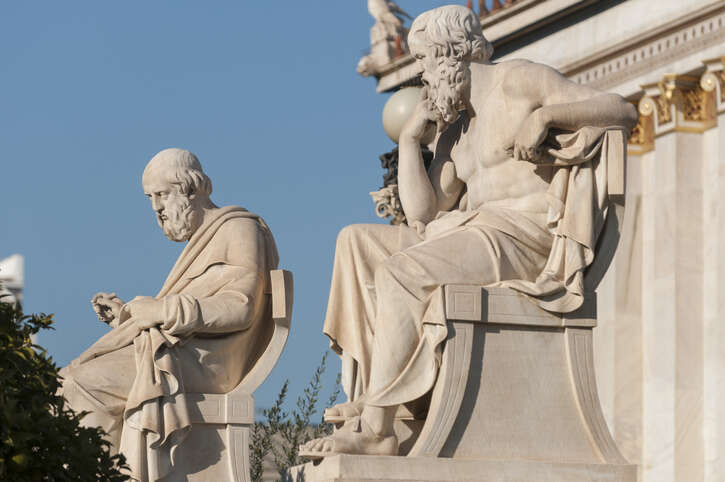
One Bottle: 2011 Château-Chalon, Domaine Tissot
It’s winter. La Réserve Thomas, Lyon; mixed company, granite light. Lunchers shuffle in, un-muffle, disburse warmth; servers dart about in preparatory rituals. Our large group gathers critical mass. Eyes flick down onto phone screens; absence usurps presence, a few desultory conversations aside. Time freewheels. Then Stéphane Tissot and his wife Bénédicte walk in.
Bottles fly from boxes, and corks seem to pull themselves unaided. Time accelerates: The Tissots are heading north, whereas we are heading east. Nobody says as much, but the conviction grows that there is no time to be lost. Stéphane, unintroduced, takes the floor, begins to talk, smilingly, bubblingly; the bottles do the rounds. Yellow wine splashes into glasses; scents of bread and leaf and sour fruit mingle with the now-fading aromas of morning coffee. The little screens are set aside and fall dark; eyes light in their place. There’s a fumbling for notebooks. He tears, rips, surges through 14 different wines, each with its story: a torrent in spate. I do my best to harvest the nuances and amass the details, but it’s like trying to stuff cats into boxes; the details scamper off, the nuances scratch, and then we’re on to the next wine…
Two decades have passed since I last met Stéphane Tissot, yet time doesn’t seem to have diminished that fierce energy and optimism, that seethe of ideas, that profusion of projects. The difference is that his vineyard holdings have more than doubled—so there is more to serve to us, to tell us, to lavish on us. Not every wine is successful—I remember that from before, too. But the great wines, the vins jaunes and the other vins de voile, are finer than ever. Did I ever realize vin jaune could be this good? I fish one conclusion out from the spate: Stéphane’s Arbois vins jaunes are very different from those he makes in Château-Chalon.
Dancing bears v forest whispers
Wait, though… Perhaps you’ve never been to the Jura, in which case I owe you a description. Clay soils give farmers options; wine regions where clay predominates are rarely monocultures. Vineyards sometimes seem an afterthought in the Jura; they’re a way of using well-exposed slopes of moderate or poor fertility. Flatter land nourishes cereals; cows cud their way about the richer pastureland and the higher plateaux; orchards punctuate the rest. From 2,000 or 2,300ft (600 or 700m), the forest takes over, climbing athletically. Vineyards here occupy nearly 2,000ha (5,000 acres); locals say they could plant 9,000ha (22,000 acres). But Comté cheese sells well, and dairy farmers covet the land, too. Jura grass is gorgeous. I rose early that next morning, to hear water seeping from the hill, to see the violet mist puddling the cold valley, to smell the smoke and the byres, to watch dawn sunlight lick the frost from every green blade.
Another 20-year memory: walking from the edge of the village of Voiteur up the steeply grassy vineyard slopes beneath the hilltop village of Château-Chalon. It was springtime on that earlier occasion: late April, suddenly warm. I counted 13 varieties of wild flower around the vineyards; an elderly peacock butterfly came to rest on my knee. The knock of cowbells hung in the air. This is where Savagnin, a sometimes gaunt old aristocrat of a grape variety, ripens slowly over a measured, temperate summer, its roots buried in sticky blue-gray marl. Château-Chalon is tiny: just 60ha (150 acres) of hill slopes in the four villages of Château-Chalon itself, Domblans, Menétru-le-Vignoble, and Nevy-sur-Seille. Arbois, by contrast, is much bigger: 12 villages and 766ha (1,900 acres) lying 18 miles (30km) to the north. Savagnin is planted on cool gray marl there, too, but the fact that most of Arbois’s vineyards are planted with red varieties suggests a little more July warmth in the air.
Savagnin is late-ripening in the Jura. It’s harvested as ripe as possible, though up here that might mean only 13% natural alcohol; it’s vinified, does malo, beds down in old casks. Sometimes an air space is left; sometimes not. In either case, one eventually develops and is followed by a thin film of yeasts—a voile, or “veil.” After six years of solicitous restraint, bottling follows, into the exquisitely dumpy little 62cl clavelin. Sometimes things lag or go wrong along the way, and the delinquent wine is hauled off for earlier consumption as a traditionally styled—that is, faintly oxidative—Savagnin. The cellar conditions matter, too; ventilation is vital, and cooler temperatures favor the Château-Chalon style, while bigger temperature variations provide an Arbois thumbprint. Alcohol levels tend to rise as the wines mature, especially in Arbois.
Stéphane Tissot’s 2011 Arbois vins jaunes, at any rate, seemed magnificently demonstrative: the nutty en Spois; the peaty La Vasée, a dancing bear; mellowed-out Mailloche, and buxom Les Bruyères. They came though the glasses like a carnival parade. And then the 2011 Château-Chalon: suddenly a countercurrent. Quietness fell in the glass. There was nuance, cream, subtlety, forest whispers; spring on the move. In the mouth, always that bolt of acidity—and as with great Riesling, all the drama of flavor is acted out inside the acidity. This is a young Château-Chalon, so the forest mushrooms, the umami beat, has barely begun. Instead, there’s a crackle of early summer fruit, of plants trodden underfoot, of crushed acorn and scuffed heather, with a dandelion-bitter aftertaste. For all the elegance, it hangs there, driving and long—stored electricity, slowly leaching its juicy yet caustic charge.




